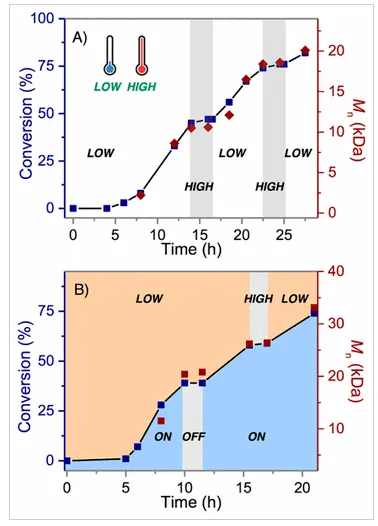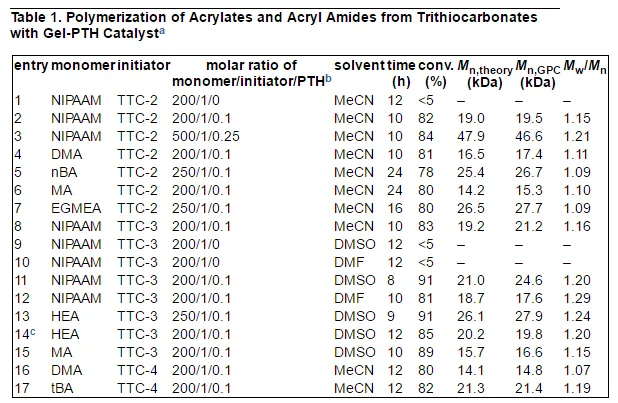Heterogeneous Organic Gel Catalyst for Photo-Controlled Chemistry
Radical polymerization is often used in the design and fabrication of new materials for a variety of applications, including but not limited to coatings, adhesives, and gels used in manufacturing processes.
Researchers
-
reactions enabled by thermoresponsive and photoresponsive gels
United States of America | Granted | 11,041,026
Figures
Technology
This invention involves a derivative of an organic photocatalyst called 10-phenylphenothiazine (PTH). This derivative is conjugated to a thermally responsive gel to create Gel-PTH in a simple three-step synthesis. When Gel-PTH is swollen in a monomer-containing solution, it provides a transparent framework through which initiators and monomers can diffuse into and begin polymerizing via photo-CRP and heat-responsive reactions. When the Gel-PTH is removed from the solution, when the temperature is increased, or when the light is turned off, the polymerization reaction is effectively turned off. In this way, polymerization is controlled by three separate stimuli—light, heat, and presence of the photocatalyst. The Inventors tested Gel-PTH catalysis using different types of RAFT and ATRP initiators and seven different types of monomers—NIPAAM (N-isopropylacrylamide), DMA (dimethylacrylamide), nBA (n-butyl acrylate), MA (methyl acrylate), EGMEA (ethylene glycol methyl ether acrylate), HEA (2-hydroxyethyl acrylate), and IBA (isobutyl acrylate.) They were able to create at a large variety of polymers with molar masses, ranging from 14.8 kDa to 46.6 kDa, by adjusting the molar ratios of the monomer, initiator, and PTH, by using different solvents, and by increasing or decreasing the time of the reaction. Furthermore, the inventors demonstrated that the Gel-PTH catalyst could be easily recycled and re-used in multiple polymerization reactions with no loss of efficiency.
Problem Addressed
The ability to initiate and control radical polymerization using light (photo-CRP) has been a recent topic of great interest in polymer chemistry. In photo-CRP applications, light can be used to activate a suitable photoredox catalyst, which induces a controlled polymerization reaction that can be terminated by shutting off the light. However, to date, nobody has designed a polymerization reaction that is responsive not only to light, but simultaneously to other types of external stimuli such as heat. Furthermore, readily recyclable photoredox catalysts are limited in scope. This type of multi-stimuli-responsive CRP, which integrates different environmental cues to produce unique polymers, could lead to the production of a much more diverse array of polymers while maintaining low catalyst loadings.
Advantages
- Simple three-step synthesis of Gel-phenothiazine (PTH)
- Robust switching of photo-CRP reactions in response to temperature, light, and catalyst presence
- Wide range of monomers including acrylates, methacrylates, acrylamides, vinyl esters and vinyl amides
- New opportunities for stimuli-responsive controlled polymerization
- Simple catalyst recyclability
Publications
Chen, M., et al. (2017). Logic-Controlled Radical Polymerization with Heat and Light: Multiple-Stimuli Switching of Polymer Chain Growth via a Recyclable, Thermally Responsive Gel Photoredox Catalyst. Journal of the American Chemical Society, 139(6), 2257-2266. doi: 10.1021/jacs.6b10345.
License this technology
Interested in this technology? Connect with our experienced licensing team to initiate the process.
Sign up for technology updates
Sign up now to receive the latest updates on cutting-edge technologies and innovations.

![Gel-PTH catalyst enables external control of photo-CRP from TTC-1 in organic solvent. (A) light “ON”/“OFF” controlled polymerization of NIPAAM in MeCN; (B) catalyst “IN”/“OUT” controlled polymerization of NIPAAM in MeCN; (C) Reaction time vs ln([M]0/[M]t), with [M]0 and [M]t being the concentration of monomers at time points 0 and t, respectively; (D) % conversion vs Mn and % conversion vs Mw/Mn.](/sites/default/files/styles/800w/public/images/19049_2.PNG.webp?itok=ji3ApxAo)
![“AND” Logic-CRP enabled by Gel-PTH catalyst. (A) Light “ON”/“OFF” and catalyst “IN”/“OUT” controlled polymerization; (B) Reaction time vs ln([M]0/[M]t), with [M]0 and [M]t being the concentration of monomers at time points 0 and t, respectively; (C) % conversion vs Mn and % conversion vs Mw/Mn](/sites/default/files/styles/800w/public/images/19049_3.PNG.webp?itok=UfPYHTZp)

